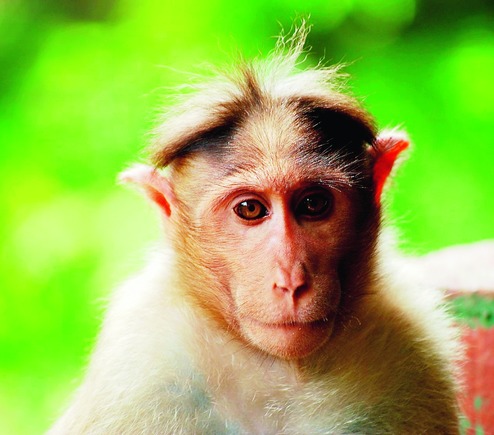

New Delhi, Sept. 9: Southern India's bonnet monkeys, although viewed as abundant and widespread, are in reality threatened by the loss of traditional habitat and territorial expansion by the bigger and more aggressive rhesus monkeys from the north, wildlife researchers have said.
The scientists who analysed the occurrence of bonnet macaques have documented consistently low population densities in forests and observed a 50 per cent decline in populations of these monkeys between 2003 and 2015 sampled along roadsides and temple premises - their adopted habitats.
"We see drastic declines in bonnet macaque populations - the monkey is classified as a species of least concern from the conservation perspective, but actually it faces serious threats," Mewa Singh, a primatologist and professor at the University of Mysore, told The Telegraph.
Singh and his colleagues from academic institutions in Bangalore, Coimbatore and Israel analysed the presence of bonnet macaques in forests through earlier surveys and their own study and established that they occur only in low densities in protected forest areas.
Scientists believe bonnet macaques over the centuries have adapted to human-dominated landscapes, thriving on roadside banyan, fig, or tamarind trees and feeding from the offerings made by people thronging temples and tourist sites.
The new study, just published in the journal PLOS One, has found a 65 per cent decline in the populations of bonnet macaques along multiple segments of roadsides over the past 25 years. The population decline was associated with decline in the roadside trees - the lower the density of trees, the lower the population.
The scientists say a gradual expansion of rhesus monkeys from northern states into southern territories is also exacerbating the habitat loss for bonnet macaques. "The available space for bonnet macaques is shrinking - they have no place to go," Singh said.
The rhesus monkeys, which are heavier and more aggressive than the bonnets, have historically been found primarily in areas north of the Tapti and Godavari rivers. But the study found that the rhesus monkeys have invaded traditional areas of the bonnets in peninsular India.
Primatologist Anindya Sinha at the National Institute of Advanced Studies, Bangalore, and his research scholars were among the first to document in 2011 the geographic spread of rhesus macaques into the southern peninsula and the possible displacement of bonnet macaques from their traditional areas.
The new assessment has estimated that the rhesus macaques have extended over an additional area of about 24,000sqkm over the past decade. The scientists are calling this a "range invasion" that is causing the further shrinking of the area available for bonnets.
"The rhesus macaques compete with bonnets for resources - they are bigger and will dominate," said Honnavalli Kumara, a scientist at the Salim Ali Centre for Ornithology and Natural History, Coimbatore, and a member of the study team.
Sinha had pointed out in the 2011 paper in the International Journal of Primatology that the spread of rhesus monkeys - natural in some areas and through the introduction by humans in others - "poses grave implications" for the populations of bonnet macaques in southern India.
Scientists say the new findings underscore the need to reconsider the status of bonnet macaques from the conservation perspective. "It's important to recognise early enough that some species that we take for granted may quietly disappear without us noticing," Sinha, who was not associated with the new study, told this newspaper.
While primate researchers have in the past observed some evidence of rhesus and bonnet monkeys coexisting, Sinha said, such mixed species troupes are not particularly common. "It is more common to see rhesus drive away the bonnets," he said.
But Singh believes the threat from rhesus monkeys is still a "small component" of the broader loss of habitat and there may still be opportunities to protect bonnet macaques in special areas where their populations appear stable and could be conserved.
One example is the Chamundi hills, a site with good vegetation, temples and tourist spots east of Mysore city, where bonnet macaque populations appear to have remained stable over the past 25 years.
"There are many similar hillocks with vegetation, temples and resident bonnet macaque populations that could also be earmarked for protection," Singh said.











